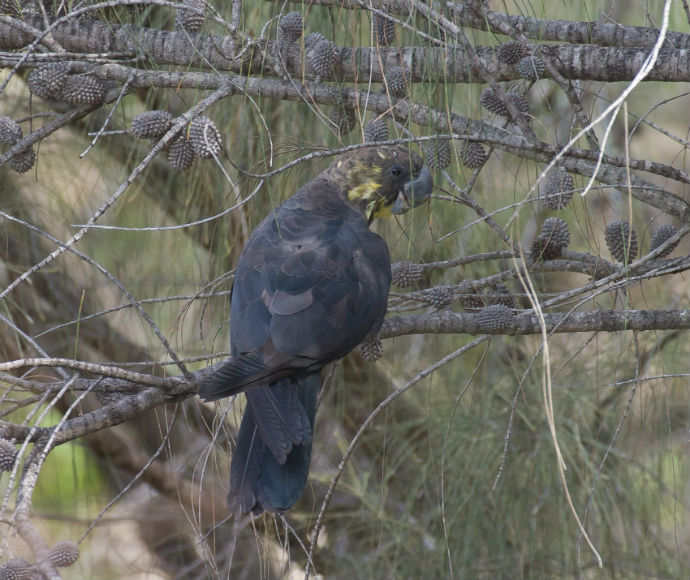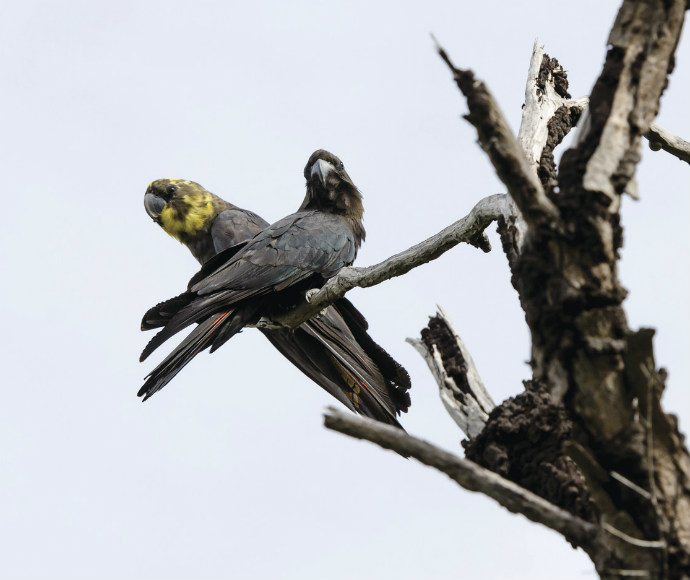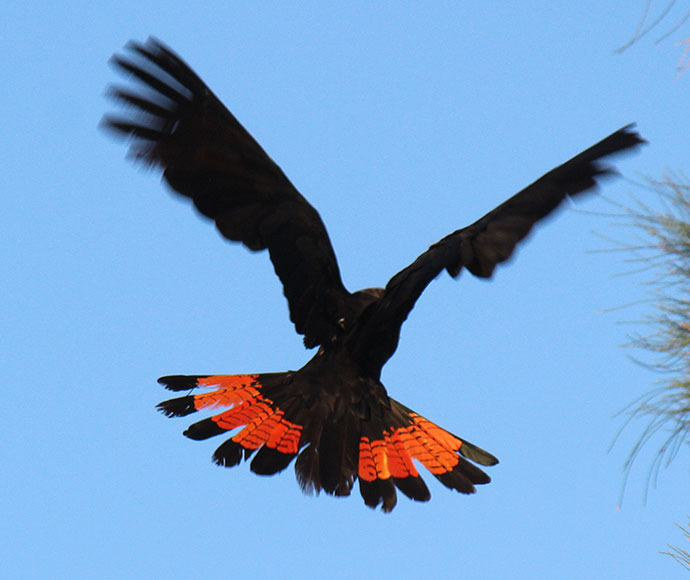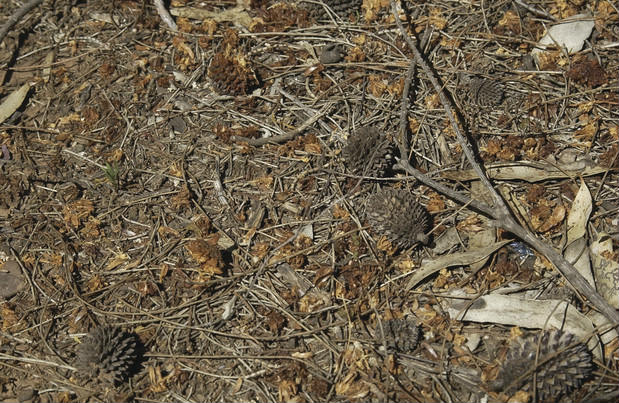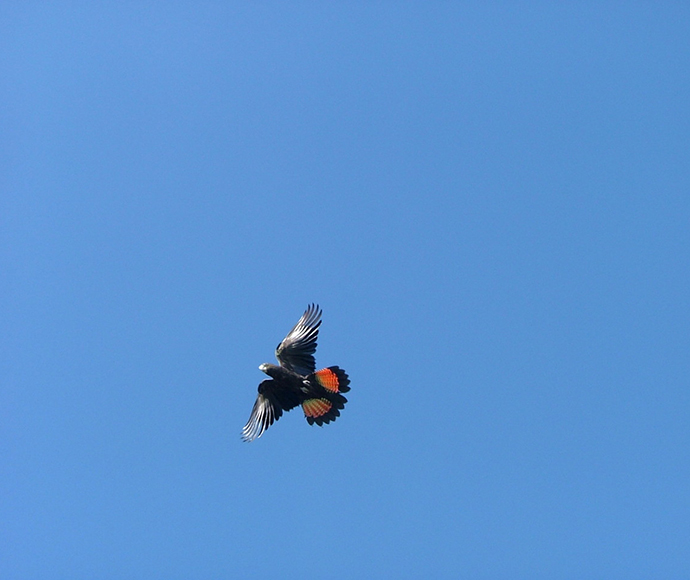The Glossies in the Mist project
The Glossies in the Mist project aims to save the glossy black-cockatoo in the Great Western Wildlife Corridor. It involves identifying key feeding trees and mapping nesting hollows in the corridor to secure the threatened birds' foraging and breeding habitat.
Because a large portion of the corridor is within private tenure, the project relies on private landowners reporting glossy black-cockatoo sightings, mapping stands of Allocasuarina and assessing feeding and hollow-bearing trees on their properties.
With funding from Saving our Species and Wingecarribee Shire Council's Environment Levy, the project aims to partner with landholders in Bullio, Wombeyan Caves, High Range, Mandemar, Canyonleigh, Belanglo, Paddys River, Wingello, Penrose, Tallong, Marulan and Bungonia areas within the Great Western Wildlife Corridor.
Learn more by watching the Glossies in the Mist video.
Glossies in the Mist
The Great Western Wildlife Corridor – why is it so important?
Located between Bullio and Bungonia, the Great Western Wildlife Corridor is an important landscape connection for the glossy black-cockatoo and the only vegetated habitat corridor between the Southern Blue Mountains and Morton National Park.
Glossy black-cockatoos require corridors of native vegetation with appropriate nesting and feeding habitat to move across the broader landscape, but the Great Western Wildlife Corridor is being increasingly divided into smaller lots and cleared for new housing and infrastructure.
Landholders, we need your help
Landholders who participate in the project will receive training to skill up on glossy identification, breeding behaviour and how to go about the searching, field assessment and reporting of favoured feeding and hollow-bearing trees.
We are also looking for landholders who are interested in conserving remnants of the Great Western Wildlife Corridor on their land. Landholders participating in the project will receive locally sourced Allocasuarina tubestock, to improve foraging habitat for glossy black-cockatoos.
Landholders participating in the project will receive locally sourced Allocasuarina tubestock, to improve foraging habitat for glossy black-cockatoos. Place an order for your Allocasuarina tubestock with our landholder tree order form.
Sign up as a landholder to participate in the project
The information you provide in this form will only be used for the purpose for which it was collected. By submitting, you consent to storage, use, and disclosure of your personal information in accordance with our privacy policy. You can request access and amendment of your personal information.
What do they look like?
The glossy black-cockatoo is around 46 to 50 centimetres long and is generally smaller than other black-cockatoos. It is a brownish black colour and has a small crest.
There are some distinct differences in appearance between male and female birds. The male can be identified by the browner colour on the head and underparts and by bright red panels in the black tail. The female has a wider tail which is red to reddish-yellow, barred with black. The female may also have yellow markings around the head.
Where do they live?
The glossy black-cockatoo lives in coastal woodlands and drier forest areas, open inland woodlands or timbered watercourses where its main food source, the casuarina (she-oak), is common.
Scientists think that glossy black-cockatoos prefer to live in rugged country, where extensive clearing has not taken place. Brigalow scrub or hilly rocky country containing casuarina species tends to be their preferred habitat in inland New South Wales.
The glossy black-cockatoo has a patchy distribution in Australia, having once been widespread across most of the south-eastern part of the country. It is now distributed throughout an area which extends from the coast near Eungella in eastern Queensland to Mallacoota in Victoria. An isolated population of glossy black-cockatoos is also known to live on Kangaroo Island in South Australia. The species has become regionally extinct in parts of western Victoria and south-eastern South Australia.
In New South Wales, the current distribution of the glossy black-cockatoo covers areas from the coast to the tablelands and extends as far west as the Riverina and Pilliga Scrub.
What do they eat?
The glossy black-cockatoo generally prefers to feed from the seeds of mature casuarina trees. The birds' presence is often indicated by a layer of cracked cones and fragments that have accumulated under favoured casuarina trees.
A study in Eden on the south coast of New South Wales indicated that the glossy black-cockatoo is selective in its choice of food trees, choosing casuarinas that produce seeds with a high nutrient value. A pair of glossy black-cockatoos may make short visits to various feed trees in a small area, checking the quality of the seeds. Once satisfied, the pair will settle in the one feed tree and harvest all the cones within reach.
Glossy black-cockatoos occasionally eat seeds from eucalypts, angophoras, acacias and hakeas, as well as eating insect larvae. In Central West New South Wales, they also eat the seeds of cypress pine.
Breeding
The glossy black-cockatoo prefers to nest in the hollows of large, old eucalypt trees, alive or dead. The typical nest site will be around 3 to 30 metres above the ground, and the nest hollow is generally lined with decayed debris. The birds tend to nest in the same areas as other nesting pairs, sometimes even sharing the same nest tree.
In New South Wales, breeding takes place from March to August. One egg, white in colour, is produced. In some instances, both the male and female parents will feed the chick, and the female will brood the chick overnight. At other times only the female will brood and feed the young.
Researchers think that glossy black-cockatoos breed throughout their range, including Goonoo and Bidden state forests, the Narrandera Range and Rankin Spring.
Threats
Habitat loss
Since European colonisation, a major threat to the survival of the glossy black-cockatoo is habitat loss – the clearing of casuarina trees in woodland areas and the loss of mature eucalypts for nest hollows.
The Riverina in New South Wales is one area in the birds' range that has suffered a major decline in population due to the removal of habitat. There has also been evidence to suggest that some glossy black-cockatoos from this region have been trapped for the illegal bird trade.
Scientists think that, to breed successfully, glossy black-cockatoos need food trees to be near their nest trees. Fragmentation of habitat reduces the chances of successful breeding.
Changing patterns of bushfires
Changes to patterns of bushfires in eastern Australia since European settlement have also contributed to the loss of habitat for the glossy black-cockatoo. Casuarina trees are very fire-sensitive and are easily killed in an intense fire. Large dead trees where the birds nest may also be destroyed in a fire.
Threats from other animals
Glossy black-cockatoos are also threatened by feral cats and possums, which raid the birds' nests. They also suffer from competition for nests from galahs and introduced honeybees.
The full impact of threats such as habitat clearing and modification on the glossy black-cockatoo is still unknown. As the bird has a relatively long lifespan, the effect of these threats may not yet be fully evident on population numbers.
In recognition of these threats, the glossy black-cockatoo is listed as vulnerable in New South Wales under the Biodiversity Conservation Act 2016. If action is not taken to stop these threats, the glossy black-cockatoo is likely to become endangered across its range in New South Wales.
Other ways you can help glossy black-cockatoos
- As the cockatoos feed mostly on casuarinas and nests in eucalypts, retain existing stands of casuarinas and eucalypts.
- Encourage regeneration and re-establish stands of casuarinas and eucalypts, which have been removed in the past due to land clearing for grazing and crops. Casuarinas and other suitable trees can also be planted in rural areas and on urban fringes to provide feeding habitat and breeding sites.
- As the cockatoos nest in both living and dead trees, removing dead trees for firewood and other uses is harmful. Glossy black-cockatoos can't nest without suitable tree hollows. Consider using fallen, dry green wood and allocate areas for wood collection on your property.
- Watch out for suspicious situations which may indicate illegal trapping or poaching. If you suspect any illegal activities, report them to Wildlife Watch by phoning 1800 819 375.
- Don't let your pets wander unsupervised at night. Domestic dogs and cats can kill glossy black-cockatoos.
Acknowledgement: We would like to acknowledge the help given by Judy Peet, Dubbo Field Naturalist Conservation Society, for technical editing of this text.
